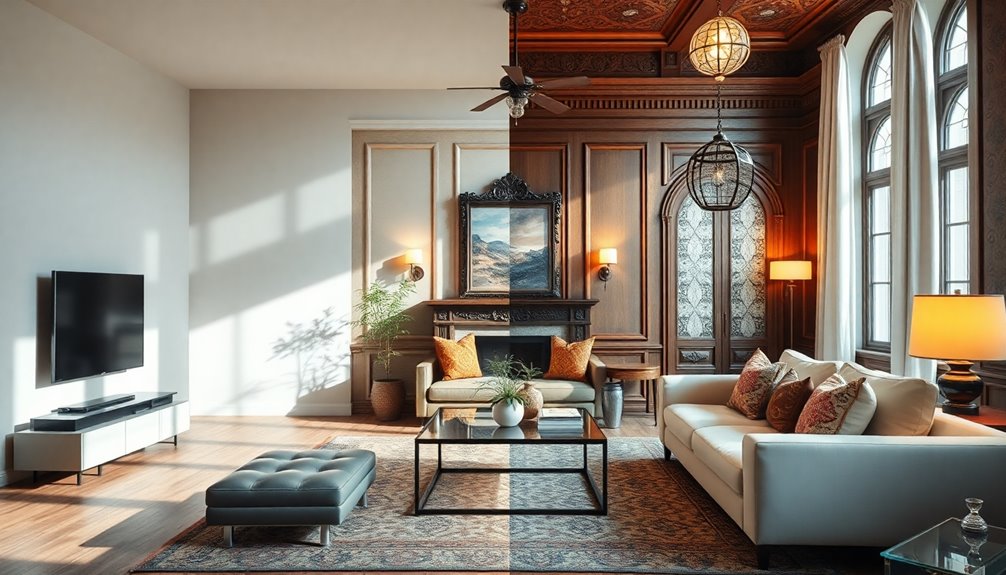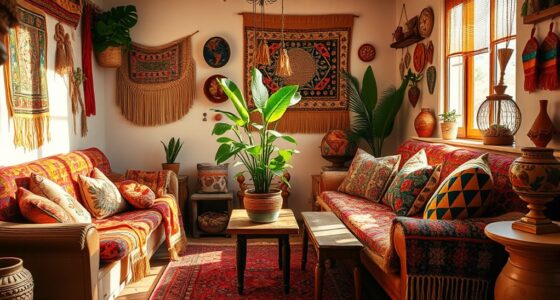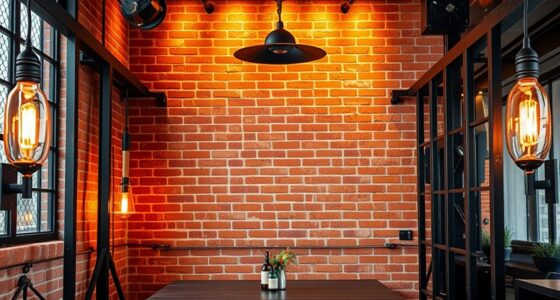When choosing between modern and traditional design, consider your lifestyle and personal tastes. Modern design features clean lines, open spaces, and functional furniture, while traditional design highlights ornate details and compartmentalized layouts. Think about whether you prefer a minimalist aesthetic or a warm, classic feel. You might also explore transitional style, which offers a blend of both styles for a balanced look. Ready to discover more insights on these styles?
Key Takeaways
- Modern design features clean lines and minimalist aesthetics, while traditional design showcases ornate details and rich woods.
- Traditional homes have compartmentalized layouts for privacy, whereas modern homes favor open-concept designs for enhanced connectivity.
- Furniture in modern design is functional and sleek, contrasting with the substantial and intricate pieces commonly found in traditional design.
- Consider personal preferences and lifestyle needs to determine which style aligns best with your aesthetic and functional requirements.
- Transitional design offers a balanced approach, combining elements of both modern and traditional styles for a personalized and cohesive look.
Overview of Modern Vs Traditional Design
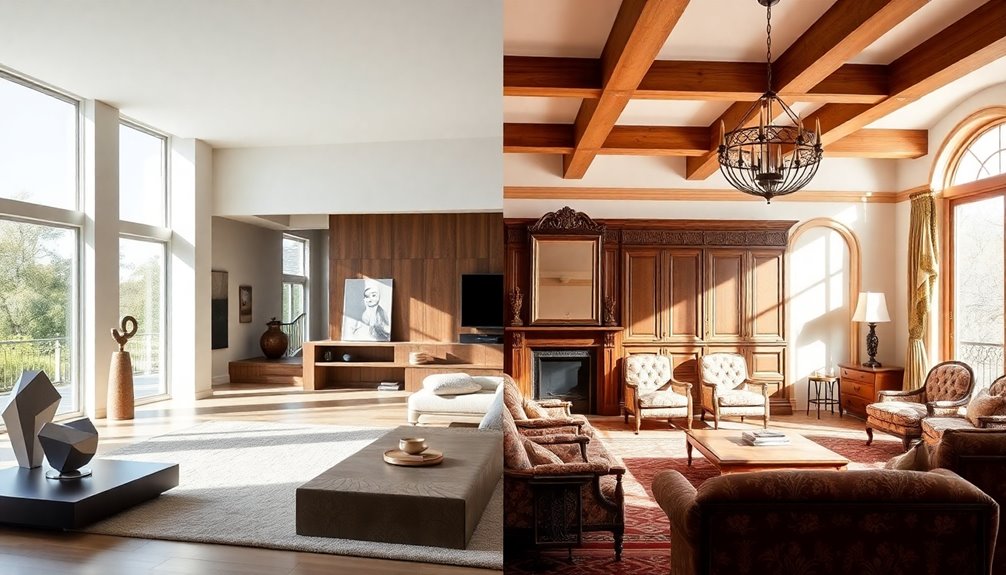
When you're deciding between modern and traditional design, it's essential to understand their key differences.
Modern design emphasizes simplicity with clean lines and a neutral color palette, creating a minimalist aesthetic appeal. In contrast, traditional design showcases ornate details and rich woods, reflecting the craftsmanship of the 18th and 19th centuries.
While modern homes embrace open-concept layouts that promote connectivity and natural light, traditional homes often feature compartmentalized floor plans that offer privacy.
The furniture styles also differ considerably; modern pieces are functional and sleek, while traditional furniture displays intricate carvings and substantial profiles.
Ultimately, your choice should align with your personal preferences and lifestyle needs, ensuring your home reflects your unique taste and comfort. Additionally, embracing mindfulness through decluttering can enhance your living space regardless of the design style you choose.
Key Differences Between Modern and Traditional Houses
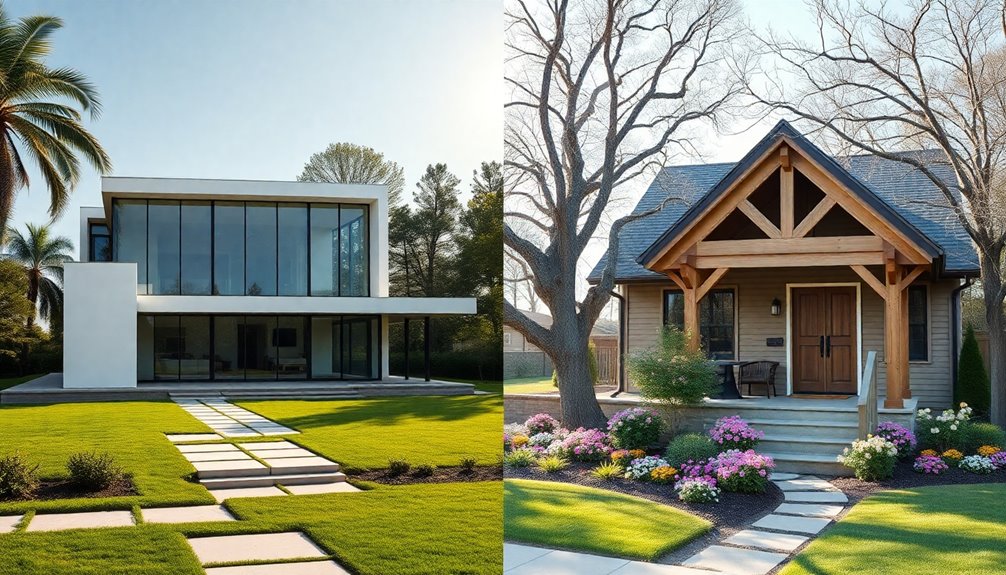
Understanding the key differences between modern and traditional houses can help you make an informed decision for your next home.
Traditional homes often feature ornate designs with intricate carvings and decorative trims, creating a warm and inviting atmosphere. In contrast, modern homes emphasize clean lines and minimalist aesthetics, promoting simplicity.
While traditional houses typically have compartmentalized floor plans for privacy, modern homes favor open-concept layouts that enhance connectivity and maximize natural light.
Additionally, traditional furniture styles tend to be more substantial and ornate, whereas modern furniture focuses on functional, space-saving designs.
The finishes in traditional homes often incorporate warmer materials like brick and timber, while modern homes utilize sleek materials like glass and steel for a contemporary look, creating a cohesive atmosphere. Modern farmhouse decor emphasizes comfort and modern aesthetics, blending traditional and contemporary elements for a unique style.
Choosing Between Modern and Traditional Styles

How do you decide between modern and traditional styles for your home? Start by evaluating your personal preferences and lifestyle needs. If you lean towards clean lines and minimalist aesthetics, modern design may be your best fit. On the other hand, if you cherish classic elegance and cozy environments, traditional design could be ideal. You might also consider blended design, which merges both styles for a balanced approach.
| Aspect | Modern Design | Traditional Design |
|---|---|---|
| Style | Clean lines | Ornate details |
| Color Palette | Neutral with bold accents | Warm, rich colors |
| Functionality | Minimalist and efficient | Comfort and structure |
| Environment | Open spaces | Inviting and cozy |
| Aesthetic | Contemporary | Classic elegance |
Benefits of Modern Design
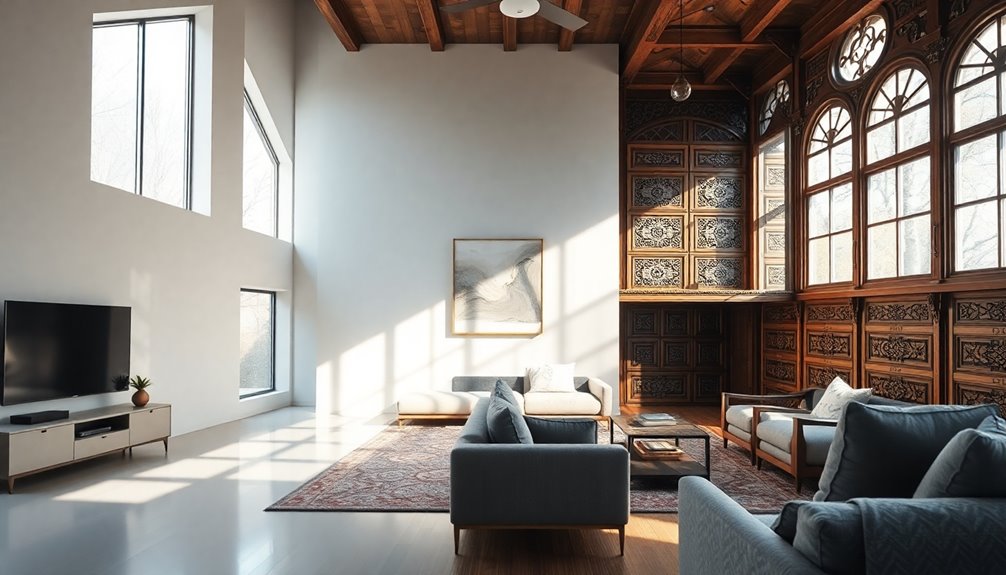
Modern design offers a fresh approach to home aesthetics, prioritizing simplicity and functionality.
You'll appreciate the open floor plans that enhance space utilization and foster connectivity within your home. Large windows flood your living areas with natural light, creating bright, airy environments that boost your well-being.
The emphasis on sustainable materials and energy-efficient appliances not only reduces utility costs but also supports eco-friendly living practices. Incorporating heat pumps, which utilize the refrigeration cycle to transfer thermal energy, can further enhance your home's energy efficiency.
With a neutral color palette accented by bold hues, you can easily refresh your decor without major renovations.
Plus, modern furniture often features multipurpose designs, perfectly catering to contemporary lifestyles that value both aesthetics and practicality.
Embracing modern design means creating a beautiful, functional, and sustainable home.
Exploring Transitional Design Options

Transformational design strikes a perfect balance between the sleekness of modern aesthetics and the warmth of traditional elements, making it an appealing choice for many homeowners.
This style creates a harmonious space by blending clean lines with rich textures, resulting in a timeless interior that feels both inviting and sophisticated.
- Utilizes neutral color palettes for seamless integration of various furniture pieces
- Emphasizes flexibility, allowing you to personalize spaces to reflect your taste
- Combines diverse materials like glass, metal, and natural wood for a unique look
With transitional style, you can enjoy the best of both worlds, appreciating modern simplicity while embracing traditional elegance. Incorporating natural materials can enhance the warmth and authenticity of your space.
It's the ideal solution for creating a cohesive and stylish environment that truly feels like home.
Frequently Asked Questions
What Is the Difference Between Modern and Traditional?
When you think about modern versus traditional design, you'll notice key differences.
Modern design embraces simplicity, clean lines, and open spaces, while traditional design features ornate details and warm colors.
You'll find modern homes use materials like glass and metal for a sleek look, whereas traditional ones rely on brick and wood.
Furniture in modern spaces tends to be minimalist and functional, contrasting sharply with the heavier, more decorative pieces of traditional styles.
What Is the Difference Between a Modern Home and a Traditional Home?
A modern home emphasizes simplicity and functionality, featuring open-concept layouts and materials like glass and steel.
You'll notice large windows that flood spaces with natural light.
In contrast, a traditional home boasts compartmentalized designs and ornate details, using brick and wood for a classic touch.
The furniture tends to be more substantial and richly textured.
Consider your lifestyle and preferences when deciding which style resonates with you more.
How Is Traditional Look Different From Modern Look?
When you compare traditional and modern looks, you'll notice distinct differences.
Traditional design features ornate details, rich textures, and warm color palettes that create a cozy atmosphere. In contrast, modern design emphasizes simplicity with clean lines and neutral colors, often punctuated by bold accents.
While traditional furniture is substantial and intricate, modern pieces are sleek and functional, focusing on minimalism.
What Is in Between Modern and Traditional?
If you're looking for a style that bridges the gap between modern and traditional, shifting design is your answer.
It blends clean lines and simplicity with warm, ornate details, creating a balanced atmosphere. You can mix modern furniture with traditional pieces, allowing your personal taste to shine.
Neutral color palettes and a variety of materials enhance visual interest, making your space feel inviting and cohesive while accommodating your family's diverse needs.
Conclusion
Ultimately, choosing between modern and traditional design comes down to your personal taste and lifestyle. If you love clean lines and minimalism, modern design might be your ideal fit. However, if you're drawn to classic charm and intricate details, traditional might be the way to go. Don't forget to explore intermediary options that blend both styles for a unique touch. Trust your instincts, and create a space that truly reflects who you are.
